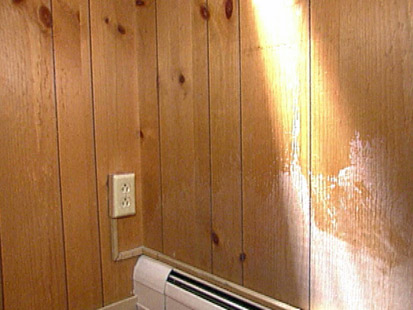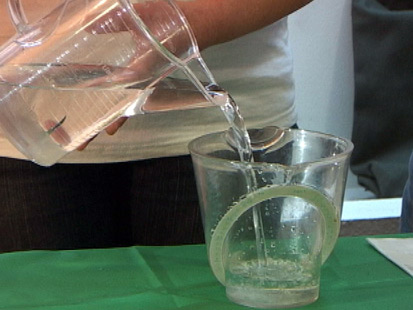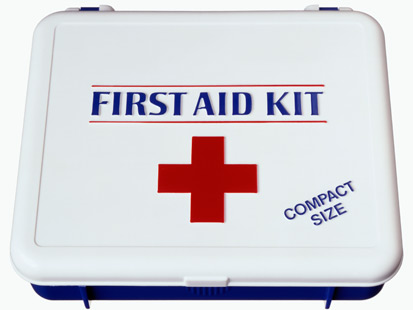10 Smart Ideas for a Healthy Home
From cleaners to alarms, how to start the new year off on the right foot.
Dec. 31, 2008 -- As 2009 approaches, many people may be scrambling to make sure that all annual around-the-house undertakings are complete. But there may be a few simple tasks, such as replacing the batteries of a smoke detector or throwing out old food, that get swept under the carpet in the excitement of the final days.
While at times our last-minute to-dos may seem like unwanted chores, these tasks may be essential for a healthier life in the coming year, according to Allen Rathey, president of the Healthy House Institute.
Introducing or eliminating simple objects around the home can contribute to a cleaner home and for many, a cleaner home may contribute to a better self, he said.
"It's certainly a better quality of life to have a healthy home," said Rathey.
According to Rathey, the benefits of a healthy home can include more money in your wallet and fewer trips to your doctor.
"Having a healthy home will simplify your life and your costs," he said.
Here are 10 simple ways to create a healthier home in 2009.
Get a Humidifier
Winter may be the best season to buy a humidifier, as the air is much drier in the winter than it is in the summer months -- and your body shows it.
So said Jeffrey May, principle scientist of May Indoor Air Investigations of Tyngsboro, Mass., and author of "Jeff May's Healthy Home Tips: A Workbook for Detecting, Diagnosing and Eliminating Pesky Pests, Stinky Stenches, Musty Mold and Other Aggravating Home Problems."

Having a humidifier running can prevent dry skin and it can also help you breathe easier by loosening up the airways and clearing congestion. But according to May, a humidifier is only effective if it has a humidistat that will help to keep the moisture at the right level.
"The risk of too much moisture in the air may cause condensation to build up on walls, which can lead to mold," he said. "And too little moisture will keep the air dry."
Having a humidifier is also cost efficient, said May. Many people will turn the heat up if the air is dry. Often, humidity makes an area feel warmer, thus allowing you to turn the heater down and save on energy.
Invest in Slip Prevention
Although slips and falls are not only the fate of the elderly, recovering from a digger is often more difficult for grandma than it is for little Johnny. According to the Centers for Disease Control and Prevention, more than one-third of American adults age 65 and older experience a fall each year.
According to Dr. Richard Della Penna, the medical director of the Kaiser Permanente Aging Network in Colorado, most older adults who slip and fall end up with minor injuries.

"Most people who slip and fall are pretty lucky and they end up with a bruise or maybe a small laceration," he said.
For fragile, older individuals, though, slipping and breaking a hip in the bathroom can cause their world to close in on them, Della Penna said. He notes that some of his patients tend to be less adventurous because of a real fear of falling.
"What we're really talking about is a threat to our independence," he said.
Della Penna recommends three slip-preventing tips to his patients: eliminate fall-provoking clutter around the house, wear proper footwear and clothing to help prevent tripping and eliminate or modify surfaces that are likely to cause slips such as scatter rugs or wet bathroom floors.
Reduce Allergens
According to May, some ways to immediately reduce allergens is to have fewer carpets and rugs. Also, buying leather furniture or covering furniture you already have with an allergen-control cover will reduce allergens in the home.
But if you are not looking to remodel or refurnish your home, just cleaning the home at least once a week may be enough to keep the home healthy, said May.

"You don't need expensive products, as long as you're cleaning on a continual basis," he said, adding that simply wiping surfaces with a damp cloth will do the trick.
However, May recommends investing in a high efficiency particulate air, or HEPA, vacuum. HEPA is a type of filter that traps the dust or mold spores that regular vacuums may circulate back into the air.
Buy Green Cleaners
Although the Food and Drug Administration regulates the safety and effectiveness of household cleaning products, it does not monitor the ingredients on the product's label, said Jess Lerner, environmental consultant and founder of greenontheinside.net.
"Most of the time, cleaning product labels will say 'do not swallow' or 'harmful if ingested,' but they don't list the ingredients and most of these chemicals are never tested to see how they interact with each other and affect us," Lerner said.

Dr. Michael Shannon, associate chief of the Pediatric Environmental Health Clinic at Children's Hospital Boston said cleaning products can have side effects including "headache, fatigue, nasal congestion, watery and itchy eyes, cough, sore throat and a worsening of asthma."
Shannon said ventilation is the most important aspect of cleaning.
"Try and not clean when children are in the house," he said.
Lerner recommended making homemade cleaners with everyday household products such as baking soda and vinegar. But if you're going to buy a commercial cleaner, she recommended looking at the label before throwing it in your shopping cart.
"Just like in food products, if there is a long name listed in the ingredients, be wary and find out what that chemical is before you use it," she said.
Consider an Air Filter... Maybe
While air filters may improve indoor air, you may want to deal with some of the actual sources of indoor air pollution first.
"Of all of the ways to keep a healthy home, a portable filter is the least important on the list," said May.

Eliminating the source of allergens, such as rugs or pets, will prevent allergens from spreading and should be the first step before getting an air filter, he said.
"It's a hopeless attempt to clean the air without removing the source that's going to continue the spores from spreading," said May.
And, contrary to what some may think, pricier air filters may not necessarily mean better quality or protection. In fact, May said some filters that cost less than $200 are more effective than some of the more expensive types.
Make Sure Smoke Detectors Work
Fifty percent of the fire deaths that occur each year in the United States take place in the 5 percent of homes without smoke detectors, according to the Massachusetts Department of Fire Services. And excess smoke exposure can lead to long-term health problems.

According to Dr. Michael Aschner, professor of pediatrics and pharmacology at Vanderbilt University in Nashville, Tenn., carbon monoxide poisoning is one of the major concerns related to excess smoke exposure.
"The best thing to do in fire is to lay low and reduce a little [of] the risk of inhaling carbon monoxide," Aschner said.
The U.S. Fire Administration recommends installing smoke alarms on every level of your home, including the basement and in between sleeping areas. They also recommend changing your smoke alarm batteries once a year.
Install a Carbon Monoxide Detector
Some states require carbon monoxide detectors in homes, but oftentimes yearly battery replacement, along with daily tasks to prevent the gas from entering the home, are neglected.
In addition to regular maintenance of these detectors, people can also practice common-sense tips to reduce their exposure to carbon monoxide. According to May, one of the most common mistakes is running a car in the garage during the winter.

"Many people think if they have the garage door open, the carbon monoxide will go outside," he said. "But the combustion of starting a car keeps some of the carbon monoxide in the garage even after you pull out of the garage."
After closing the garage door, carbon monoxide lingers and may even move into the home.
"The simplest way to avoid this is to run the car outside," he said.
Have a First Aid Kit Handy
To be prepared for most types of emergencies, the American Red Cross recommends having a first aid kit handy in your home and in your car. The complexity of the kit, however, depends on how comfortable you feel administering the first aid, Shannon said.
"If a parent knows how to splint an arm, then the family could buy a first aid kit that has more complex first aid devices in it," he said. "The parent that doesn't feel so comfortable can buy a basic first aid kit."

Shannon said first aid kits can be broken down into different levels of complexity. The basic level consists of tape, Band-Aids, large gauze pads, an antiseptic and medications like Tylenol or Benadryl. The highest level kit would include things like Epi-pens, splints and slings, and a midlevel kit would include a combination of the two.
Regardless of what the first aid kit contains, accessibility to it is most important, he said.
"A first aid kit should be kept someplace where every family member knows of and can reach it," said Shannon.
Food Preservation
While some of the easiest ways to detect spoiled food may be to check the expiration date or see mold, not all rotten foods are that easy to spot.
In fact, nonrefrigerated foods such as chips, crackers and grains can go bad long before we notice they are stale or dried up, May said.

According to May, some kitchen pantries that store dry foods may contain flour moths -- insects that spin silk tubes with eggs into dry food, but go unnoticed.
"If you look inside any package of crackers and see these light threads, it's an indication of flour moths," said May.
But that may not necessarily mean that it is time to throw the package away, said May. If the package does not look infested with flour moths, and only a few silk threads are seen, May said microwaving 30 seconds per half pound of the dry food will kill the eggs of flour moths.
Radon Testing
Radon is an invisible, colorless, odorless gas -- and according to Shannon, it is one of the leading causes of lung cancer.
"The physical effects of radon exposure are essentially none," Shannon said. "Without a radon test, you'll have no idea it's even in your home."

Philip Jalbert, radon team leader for the Environmental Protection Agency, said testing for radon is simple.
"The most common and simplest test is the passive radon detector, which is easily available over the phone or on the Internet," said Jalbert. "Once the initial radon test is performed in your home, it should be done once every two years to make sure that the levels haven't changed."
Most of the kits available are either round tin cans, foil bag devices or small plastic vials, all of which typically contain charcoal. The charcoal absorbs radon gases and is later measured in the lab for concentration. Testing typically lasts anywhere from two to seven days, and results could be available in as little as three days, Jalbert said.
If radon levels are above 4 picocuries per liter (pCi/L) of air, the EPA recommends a technique called "active soil depressurization." According to Jalbert, this is a pipe with a fan in it that increases ventilation beneath the slab of the house so the gas won't be able to enter the house.
January is National Radon Action Month and for more information on radon detection, visit the EPA Web site at www.epa.gov/radon.